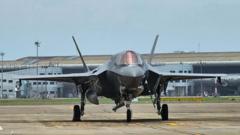The F-35B fighter jet belonging to the UK has been cleared for take-off following more than five weeks stuck at Thiruvananthapuram airport in Kerala, India. Initially diverted to the airport due to inclement weather during a mission in the Indian Ocean, the state-of-the-art aircraft developed a technical snag soon after landing on June 14.
An airport spokesperson confirmed the jet is set to leave on Tuesday after being pulled from the hangar for final preparations. However, no technical details regarding the repairs have been disclosed. The aircraft's extended detainment in a foreign country raised eyebrows and led to widespread speculation about the capabilities and vulnerabilities of modern military jets.
The F-35B is a critical part of the fleet for the HMS Prince of Wales, a Royal Navy aircraft carrier. After encountering issues, engineers from the carrier were dispatched to assess the problem but were ultimately unable to rectify it alone. About two weeks ago, the UK Ministry of Defence sent a 14-member team of engineers equipped with specialized tools to fix the aircraft.
Visuals captured over the past weeks depicted the F-35B being towed to a maintenance facility at the airport, leading to public discussions and humor over its prolonged residence in what many consider the picturesque state of Kerala, known as "God's own country." Speculations also circulated regarding the possibility of dismantling the jet and transporting it via larger cargo planes if repairs were unsuccessful.
The high commission of the UK in India and defence authorities have remained tight-lipped about the ongoing repair efforts despite repeated inquiries. As of Monday, an official announced that the jet has regained its airworthiness. While the exact details—including the refueling location and the timeline for departure—remain unclear, the airport is poised for what many hope will be a smooth exit for the F-35B.
This incident has garnered attention beyond aviation circles and even made its way into dialogue in the House of Commons, indicating its broader implications for UK military operations abroad.
An airport spokesperson confirmed the jet is set to leave on Tuesday after being pulled from the hangar for final preparations. However, no technical details regarding the repairs have been disclosed. The aircraft's extended detainment in a foreign country raised eyebrows and led to widespread speculation about the capabilities and vulnerabilities of modern military jets.
The F-35B is a critical part of the fleet for the HMS Prince of Wales, a Royal Navy aircraft carrier. After encountering issues, engineers from the carrier were dispatched to assess the problem but were ultimately unable to rectify it alone. About two weeks ago, the UK Ministry of Defence sent a 14-member team of engineers equipped with specialized tools to fix the aircraft.
Visuals captured over the past weeks depicted the F-35B being towed to a maintenance facility at the airport, leading to public discussions and humor over its prolonged residence in what many consider the picturesque state of Kerala, known as "God's own country." Speculations also circulated regarding the possibility of dismantling the jet and transporting it via larger cargo planes if repairs were unsuccessful.
The high commission of the UK in India and defence authorities have remained tight-lipped about the ongoing repair efforts despite repeated inquiries. As of Monday, an official announced that the jet has regained its airworthiness. While the exact details—including the refueling location and the timeline for departure—remain unclear, the airport is poised for what many hope will be a smooth exit for the F-35B.
This incident has garnered attention beyond aviation circles and even made its way into dialogue in the House of Commons, indicating its broader implications for UK military operations abroad.




















